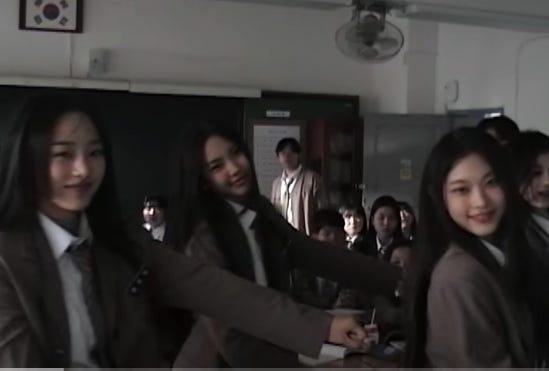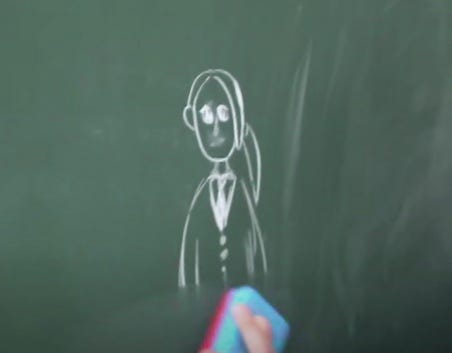I never thought there’d come a day when I’d be close reading a K-pop music video. But this is NewJeans. And to be honest, I’ve been wanting to try out my close reading analysis skills on a non-literary work.
Speaking of honesty, that’s the theme of today’s post.
NewJeans’ most recent release “Ditto” (watch the music video here: side A, side B) is narrated through multiple angles and layers—alternating points of view, voyeuristic frames, spatial motifs—but they all mediate a single truth. A truth that can make or break a brand.
For the purpose of making this post easy to follow, I’m going to:
A) walk you through the “Ditto” story
B) analyze the narrative devices employed
C) extrapolate insight applicable to branding
A) The “Ditto” Story
The music video for “Ditto” can be understood and interpreted on multiple levels.
Superficial level: A woman named Ban Hee-Soo (반희수) recollects her high school memories by playing an old VHS tape. A young Hee-Soo is shown filming her friends—NewJeans—with a camcorder or watching them from afar, while also consciously ignoring a guy she has an interest in. Her friends disappear after she wakes up from a nap one day.
Leaving the story at just this prompts most people to speculate if NewJeans are a ghost or somehow suddenly dead—a take that adds a dimension of horror to the otherwise innocent story.
But any well-versed K-pop fan or close reading analyst worth her grain of salt would venture beyond such a reading.
Deeper level: Teenager Hee-Soo conjures up a group of imaginary friends based off her then favorite idol group, NewJeans, to stave off feelings of loneliness at school. She is practically filming nothing when she points her camcorder to what we see as a dancing and laughing NewJeans; hence, the weird stares she gets from her classmates. Hee-Soo struggles to let go of her parasocial relationship with NewJeans, but eventually moves on when feelings for her crush develop into an actual relationship.
In short, “Ditto” is a story about growth and loss. We lose our connection with people, places, and feelings as we mature, as we grow out of our various phases of adolescence, leaving behind a palimpsest of memories in their wake; memories that we reconstruct a little bit differently each time we relive it, thus altering the past even though it is unchangeable.
For Hee-Soo, who represents the NewJeans fandom “Bunnies” (pronounced buhn-hee-zu in Korean…Ban Hee-Soo…get it?), her high school days are marked by a strong sense of longing. A longing to belong. A longing to fit in. A longing for reciprocation. Emotions that resonate with almost every teen (and post-teen entity) on a transnational level. This feeling of emptiness is heightened by the various devices I’ll discuss in a bit throughout the entire music video, leaving viewers with a soft ache at the end.
B) The Narrative Devices
Before deep-diving into the devices that give the “Ditto” music video that eerie nostalgia that’s hard to shake off, I want to first examine the lyrics as they establish the story behind the narrative.
The lyrics
“Oh say it ditto” insinuates a longing for reciprocation. Hee-Soo wants her emotions to be reciprocated on mainly two fronts: friendship and love. She wants a group of friends who she can fall back on the way she supports NewJeans. She wants the boy she likes to like her back. Ditto level 3 of Maslow’s pyramid.
“I don’t want to walk in this miro (miro or 미로 is the Korean word for maze)” refers to the confusion Hee-Soo feels as she tries to make out her identity of who she is, where she belongs, etc. The journey to define oneself as a teen, a stage during which self-identity is heavily influenced by friendship, is tumultuous and wrought with emotional ups-and-downs.
Now time to dissect the goosebump evoking elements.
Alternating camcorder scenes
Hee-Soo’s camcorder is a device that puts distance between her and NewJeans via an artificial frame, and represents the tantalizing nature of their relationship. This distance is reminiscent of the digital divide that separates K-pop fans from their beloved idols; most fans connect with their idols through a screen, cheering wholeheartedly regardless of whether their idol recognizes their existence. Hee-Soo’s gaze, which is formulated and percolated by the camera lens, projects both her adoration and her desire to fit in onto the group of dancing girls.
That NewJeans is a fabricated being, a figment of Hee-Soo’s imagination, is hinted at by the alternating camcorder scenes taken at school. The same scene is shown twice: once from Hee-Soo’s imaginary point of view and once again from the perspective of reality. Laughing girls exist in one frame, while silence pervades the other. Such alternations prompt the audience to question Hee-Soo’s reliability as a narrator—to what extent do we trust her gaze? How do we define the parameters of what is real?
Deer
In both sides A and B of the music video, a deer appears in a snow covered clearing and deserted hallway; spaces that I call “spatial voids”. No one is present save Hee-Soo and the deer, who stare at each other in unblinking silence. Both spaces are voids in which Hee-Soo’s loneliness echoes throughout. Only the deer, whose docile gaze invokes NewJeans’ purity, can enter this space to offer Hee-Soo what little comfort it can from a distance. It’s worth noting that the distance between Hee-Soo and the deer parallels the distance created by the camcorder, thus mediating to viewers that the deer is a spiritual representation of NewJeans. When the deer walks away, it signals the end of Hee-Soo’s parasocial relationship.
Cast
Teenage Hee-Soo is seen wearing a cast on her left arm throughout the entire video. It’s common knowledge that we wear a cast when we’ve been hurt and need to heal. Thus, it’s possible to construe this cast as a symbol of vulnerability that reifies Hee-Soo’s struggle to find a group of friends she can identify with. A lot of netizens have already pointed out that Danielle writes “don’t die (죽지마)” on Hee-Soo’s cast. My take on this heartfelt plea is that it’s an allusion to South Korea’s high suicide rate, which is undergirded (sadly) by a culture in which loners or wangdda (왕따) are ostracized; every year some number of teenage students commit suicide due to bullying or hak-pok (학폭).
Motif of Effacement
Despite NewJeans being a manifestation of Hee-Soo’s wistful thinking, they gently remind her that she needs to move on.
Haein says “Hee-Soo, that’s not it (희수야 그거 아니야)” in a playful manner at the beginning of side A. However, this phrase takes on a foreboding tone towards the end of the video when it repeats in juxtaposition to a montage of Hee-Soo’s hallucinations. NewJeans’ youngest, Haein, is warning Hee-Soo that she can’t forever hide out in an imaginary world she’s erected with her camcorder.
Minji slowly erasing a chalkboard illustration of Haerin signals to viewers that the NewJeans conjured by Hee-Soo is fated to expire. It should be noted that Minji and Haerin are notorious for sharing a sisterly relationship in real life e.g. Haerin steals Minji’s bunny toy, Minji fixes Haerin’s hair, etc. Thus, the fact that Minji is erasing Haerin from the chalkboard implies that even the strongest of bonds sometimes have to be let go for the better.
C. The Branding Takeaway: Be Honest
If you’ve read this far, you’re amazing. So you might as well stay for the finale.
The “Ditto” narrative is metaphorically meta in that it depicts the parasocial relationship between K-pop fans and their idols. What’s surprising is that NewJeans, an idol group heavily reliant on its Bunnies fandom, uses their music video as a vehicle to prompt discussion on this subject.
Such honesty is shocking to the point that it’s audacious—why would an idol want to direct attention to the whole parasocial aspect of the K-pop industry?
The answer is quite simple: because people eventually realize the truth.
K-pop fans will one day outgrow their idols, move on, find another subject (read: cat) to lavish their affection on, and realize in hindsight that their relationship with their idol was all in their heads. BTS knows this. Min Hee Jin knows this. NewJeans knows this. Even the most ardent K-pop fan will one day know this. Yet, NewJeans is the first to acknowledge the ephemerality of their parasocial presence.
What makes their acknowledgement so poignant is the way in which it is communicated: “Ditto” relays to viewers that even though NewJeans can’t be personally befriended, their music, dance and energy will always be there for those who seek it. This promise is demonstrated by the girls’ shouts of “it’s been so long (오랜만)” at the end of side B as an adult Hee-Soo recalls them to life.
Honesty is refreshing because it is seldom observed. It’s also timeless. When we do encounter candor from a brand, it haunts us because it’s eluded us for so long.














Who would have thought a new girl group would be delivering such houghtful messages in their music videos? I really believe NewJeans are as successful as they are because of the stories they share. From Ditto to Hype Boy, I love how they show different perspectives through separate versions for each song. They give something fresh each and every time. I like bubble gum pop as much as the next person, but I also love coming out of watching music videos with a deeper meaning. More of this please in K-pop!